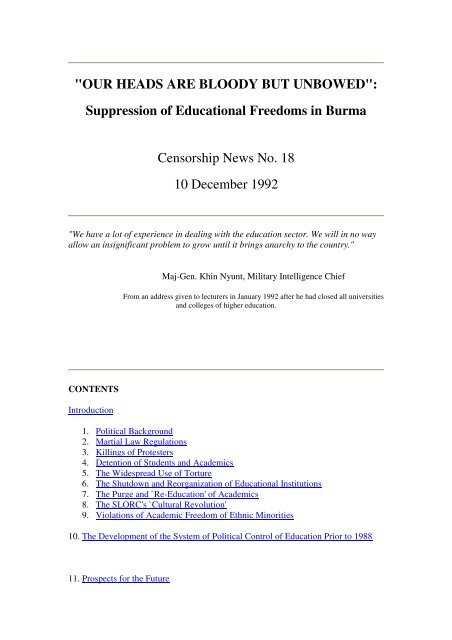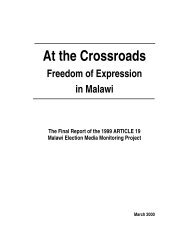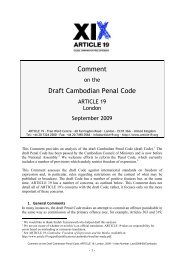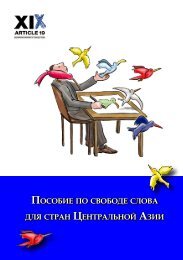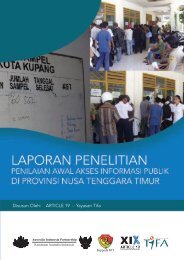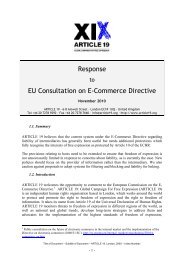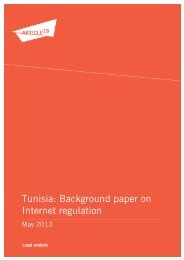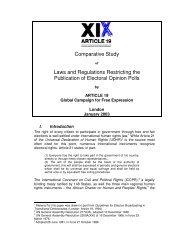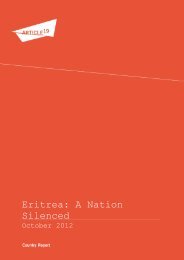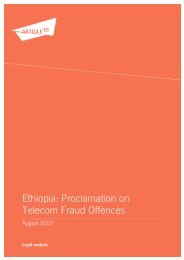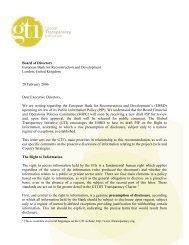"OUR HEADS ARE BLOODY BUT UNBOWED ... - Article 19
"OUR HEADS ARE BLOODY BUT UNBOWED ... - Article 19
"OUR HEADS ARE BLOODY BUT UNBOWED ... - Article 19
You also want an ePaper? Increase the reach of your titles
YUMPU automatically turns print PDFs into web optimized ePapers that Google loves.
"<strong>OUR</strong> <strong>HEADS</strong> <strong>ARE</strong> <strong>BLOODY</strong> <strong>BUT</strong> <strong>UNBOWED</strong>":Suppression of Educational Freedoms in BurmaCensorship News No. 1810 December <strong>19</strong>92"We have a lot of experience in dealing with the education sector. We will in no wayallow an insignificant problem to grow until it brings anarchy to the country."Maj-Gen. Khin Nyunt, Military Intelligence ChiefFrom an address given to lecturers in January <strong>19</strong>92 after he had closed all universitiesand colleges of higher education.CONTENTSIntroduction1. Political Background2. Martial Law Regulations3. Killings of Protesters4. Detention of Students and Academics5. The Widespread Use of Torture6. The Shutdown and Reorganization of Educational Institutions7. The Purge and `Re-Education' of Academics8. The SLORC's `Cultural Revolution'9. Violations of Academic Freedom of Ethnic Minorities10. The Development of the System of Political Control of Education Prior to <strong>19</strong>8811. Prospects for the Future
During the same period, however, the crackdown on education has intensified.Following another outbreak of protests at Rangoon and Mandalay Universities inDecember <strong>19</strong>91, all universities and colleges of higher education were again closeduntil September <strong>19</strong>92. In the meantime the SLORC has hastened its purge andrestructure of the education system. Thousands of lecturers and administrators inhigher education were sent away on "re-education" courses where, dressed in militaryuniform, they were forced to undergo drilling by army instructors. Subsequently manywere sacked, bringing to over 7,000 the number of teachers and educationaladministrators reported to have been dismissed in the previous year alone.Undoubtedly the harshest treatment, however, is reserved for the students. Since <strong>19</strong>88thousands of young people have been arrested under the SLORC's tough martial lawrestrictions and many have been brutally tortured. With the constant closure of thecolleges, for four years now few students have been able to either enter or graduatefrom university. The SLORC appears determined to prevent any resurgence ofpolitical activity in schools or on the college campuses. Right across the countryvirtually every democratic right of association, publishing and communication hasbeen banned.Meanwhile, in the ethnic minority borderlands, where an estimated 2,000 students stillremain with armed ethnic nationalist forces, Burma's social and political crisiscontinues to mount. Since <strong>19</strong>88 a combination of ethnic persecution and fiercefighting has sent over 350,000 refugees across Burma's borders to take refuge inneighbouring Thailand, Bangladesh, India and China. In many communities in theseborder areas all schooling has come to an end.Four years after the SLORC generals came to power, across the country the collectiveresult of this sustained attack on education and academic freedom is the pervasiveatmosphere of fear, stagnation and deep malaise which today permeates through allsectors of Burmese society.Yet the need for the immediate unshackling and revitalization of education in Burmahas never been more acute. The problems facing the country's 42 million inhabitantsare formidable. The number of refugees and internally-displaced peoples is risingrapidly. Since <strong>19</strong>88 Burma is estimated to have become the world's largest producerof illicit opium and heroin. Equally alarming, with over 100,000 estimated HIVcarriers, AIDS is spreading rapidly unpublicized and unresearched into manycommunities. Finally, environmental disaster is looming as Burma's once great forestsare rapidly cut. Burma's scientists and scholars are agreed. Without the restoration ofall rights of expression and academic freedom, none of the great crises facing theircountry will ever be properly researched or redressed.2. MARTIAL LAW REGULATIONS
Military control is absolute over all aspects of education in Burma today. Academicfreedom has been completely stifled by the same labyrinth of laws and martial lawdecrees with which the SLORC has suppressed all national and political life.The laws most commonly employed by the SLORC have been the <strong>19</strong>50 EmergencyProvisions Act, the <strong>19</strong>57 Unlawful Associations Act, the <strong>19</strong>62 Printers and PublishersRegistration Law and the <strong>19</strong>75 State Protection Law. Each provides for long periodsof imprisonment for citizens adjudged guilty of criticizing the government.These laws have been backed up by summary detention and the use of force under asuccession of sweeping martial law decrees. As the former SLORC Chairman, Gen.Saw Maung, warned in May <strong>19</strong>91: "Martial law means the will of the ruler. He can doanything he wishes to do."Under SLORC Order No.2/88, issued on the day of the coup, all public gatherings ofmore than five people were banned "regardless of whether the act is with the intentionof creating a disturbance or of committing a crime". Student or independent campusnewspapers and publications, which had briefly flourished during the democracysummer, were outlawed under Order 8/88 prohibiting any literature or activities"aimed at dividing the Defence Forces".Later, when protests escalated again in July <strong>19</strong>89 during the arrest of Aung San SuuKyi and the NLD leadership, military tribunals were set up across the country underMartial Law Orders Nos. 1/89 and 2/89, empowered to enforce only three possiblepenalties - death, life imprisonment or a minimum of three years' hard labour. Thesetribunals were apparently disbanded on 26 September <strong>19</strong>92, according to state radio,due "to the improvement in stability" and "the wishes of the people". However, manyother martial law restrictions remained in force and no convictions were quashed onany of those who had been sentenced.Under these basic laws and martial law decrees, students and intellectuals are believedto form the largest social group amongst the thousands of democracy activists arrestedby the SLORC. Amnesty International has documented the detention of over 1,500political prisoners since <strong>19</strong>88 but believes this figure "represents only a smallproportion of the total number". Details of court cases and arrests are onlyspasmodically released, usually only in the main conurbations. The cases of manycitizens who have disappeared remain undocumented.3. KILLINGS OF PROTESTERS
Of particular concern to many families is the failure of the SLORC to allow anyinvestigation into the shooting or killing of hundreds of students and other civiliansduring the break-up of street protests between March and September <strong>19</strong>88 inRangoon, Moulmein, Sagaing, Bassein and other towns across the country. In anofficial reply to the Independent Expert of the UN Commission on Human Rights theSLORC claimed only 15 "demonstrators" had died following its assumption of power,but it did admit 516 "looters" had also lost their lives. The SLORC also recorded thedeath of another <strong>19</strong>2 citizens during August <strong>19</strong>88.Opposition groups, however, say these figures are a grave underestimation. No soldieror official has ever been brought to trial for any single incident. For example, inMarch <strong>19</strong>88 41 students suffocated to death in a police truck on the way to InseinPrison. At first the authorities released a whitewash report in which only two deathswere admitted. Subsequently, to a background of growing public outrage, theauthorities were forced to acknowledge this appalling violation. The Home andReligious Affairs Minister, U Min Gaung, resigned, but no official was brought tojustice for this crime.A number of teachers and monks have also been the victims of the army's "shoot-tokill"policy. Schoolchildren from the southern town of Tavoy who fled to the Thaiborder reported that the headmaster of Tavoy State Middle School, U Pan Kyaw, wasshot dead in full view of the townspeople by the local army commander, Lt.-Col.Myint Thein, on <strong>19</strong> September <strong>19</strong>88. Another local teacher, U Chan Hla, was alsokilled as troops opened fire on the crowd.There have also been persistent reports of the extrajudicial execution by the Burmesearmy of students who have escaped into territory controlled by armed oppositiongroups. Some of those killed were known to be carrying weapons at the time of theirarrest, but others were unarmed. The first reported execution was of a final yearRangoon University psychology student, Mahn Moe Kyaw Zan, who was beheadedby government troops near the Thai border on 14 November <strong>19</strong>88. Most killings,however, have gone unrecorded. Armed ABSDF students themselves executed 15 oftheir own members in the Kachin State in February <strong>19</strong>92.4. DETENTION OF STUDENTS AND ACADEMICS
After the violent ending of the "democracy summer", martial law regulations havemostly been used by the SLORC to prevent the gatherings of political activists and thedissemination of anti-SLORC literature through the summary detention of thousandsof dissidents. Next to the NLD, the main parties decimated by arrests have been theAll Burma Federation of Students Unions (ABFSU), an independent student unionwhich has co-ordinated many of the student protests since its formation in August<strong>19</strong>88, and the Democratic Party for New Society (DPNS), a student-backed youthparty which legally stood in the <strong>19</strong>90 election. Like the NLD, both parties publiclycommitted themselves to non-violent action in the campaign for democracy.Many of the individuals initially detained under martial law regulations havesubsequently been sentenced to long jail terms. For example, Min Ko Naing (realname Paw U Tun), chairman of the ABFSU, which at one stage claimed over 50,000members, was later reportedly sentenced to 20 years' imprisonment. He was arrestedin March <strong>19</strong>89 under SLORC Order No. 2/88 prohibiting gatherings of more than fivepeople. The ABFSU's general secretary, Aung Din, a 29-year-old engineering student,was sentenced to 15 years. In June <strong>19</strong>90 another important student leader, Min Zeya,chairman of the smaller All Burma Students Democratic Association, was reportedlysentenced to eight years in jail.Even schoolchildren have not been spared. Aung Soe, a 15-year-old pupil fromMayagon Township State High School was reportedly arrested in August <strong>19</strong>90 fortaking part in a student protest and sentenced to seven years in jail. In April <strong>19</strong>90another schoolboy, 14 year-old Win Thein from North Okkalapa, and two other 8thgrade schoolboys, Kyaw Soe and Thein Tun U, were reportedly sentenced to 13 years'imprisonment by military tribunal for putting up anti-government posters at theirschool.The SLORC has similarly used the law to restrict the activities of Buddhist monkswho, in a land over 80 per cent Buddhist, still play a respected teaching role insociety. In rural areas especially monasteries remain a centre for education andcommunity life. The Venerable U Kaweinda, who had been the leader of the the AllMandalay Strike Committee in <strong>19</strong>88, was arrested by Military Intelligence Service(MIS) agents in June <strong>19</strong>89 and reportedly sentenced to 17 years' imprisonment. Thenwhen a religious boycott of soldiers and their families was organized by young monkorganisations, over 350 monasteries were raided and hundreds of monks, includingthe Venerable U Yewata, the head of the Mandalay Monks Association, weredetained. According to the SLORC's own account, most were arrested for thepossession of literature deemed to be anti-SLORC. Such offending materials includedthe monks' U Ottama journal, NLD booklets and, in three cases, poems which youngmonks had written in their diaries.
The SLORC also pursues students and academics suspected of support for theoutlawed Communist Party of Burma (CPB). The CPB virtually collapsed in early<strong>19</strong>89 following a series of ethnic mutinies and defections in the Shan State. However,this has still not stopped the highly-publicized exposé by the SLORC of communist"conspiracies" around the country to justify the use of martial law restrictions. Forexample, in his "Red Book" of September <strong>19</strong>89, the MIS chief, Maj-Gen. KhinNyunt, published mug shots and biographies of a number of alleged CPBsympathizers who had been arrested. These included Khin Maung Aye, a 38 year-oldteacher at Pakhokku State High School, Than Naing Oo, a Mandalay University MAstudent and high school teacher, Aung Kyaw Sunn, a Rangoon University physicsstudent, Myint Soe, a 41 year-old librarian in the Medical Education Department, andSan Myint, a 36 year-old tutor in Rangoon. Most were accused of circulating "leftist"or pro-CPB literature or of having alleged communist contacts. Their sentences,however, were not recorded.5. THE WIDESPREAD USE OF TORTUREThe use of torture is widespread in Burmese prisons today. United Nations,diplomatic and independent observers have all been denied permission to visitpolitical prisoners by the SLORC. Amnesty International, however, has been able toidentify at least 20 detention centres where brutal interrogation has taken place.Documented forms of torture include beatings, electric shocks, sleep deprivation andvarious forms of water torture.Such methods have been used against every section of society since <strong>19</strong>88, but manyobservers believe the security forces have a special vengeance against students andethnic minorities. Students accused of political offences are kept in appallingconditions and frequently refused visiting rights or pens and other writing materials.Even after torture has finished students still face harsh treatment. In one extremelydisturbing example in mid-<strong>19</strong>89, some 500 political prisoners including students weresent from Insein Prison on a "death march" to the war-front in the Kachin Statecarrying arms and supplies for the Burmese army. Large numbers were reported tohave died along the way and remain unaccounted for. In early <strong>19</strong>92, thousands ofcommon criminals were also subjected to similar treatment and sent to the Karen warfront.In another incident in September <strong>19</strong>90, student prisoners were singled out andsystematically beaten for their role in organising a hunger strike by political prisonersat Insein Prison in protest at the second anniversary of the SLORC's assumption ofpower. According to eyewitnesses interviewed by Amnesty International, over 40prisoners required hospitalization and six may have died. These charges, however,were denied by SLORC officials who stated only "internationally-recognized batons"had been used to control the hunger-strikers. (4)
Many students and academics who have been subject to beatings and ill-treatmentclaim that they were arrested and tortured by MIS agents trying to uncover antigovernmentactivity at random. For example, a middle-aged lecturer at RangoonWorkers' College described how he was seized by MIS agents from Unit 5 on the wayto Moulmein in July <strong>19</strong>89. Kept blindfolded, he was deprived of food and sleep forfive days and subjected to various forms of psychological torture, including beingforced to watch the beating of another detainee, before being left standing in ashallow narrow well for three days. He was then released without explanation orapology.Other ex-prisoners say they were tortured because of suspected involvement withstudent organizations or other political parties. Ko Thet, a 25-year-old RangoonUniversity mathematics student and ABFSU member, was subjected to horrifictorture after being arrested by MIS agents from Unit 6 in Rangoon shortly after thedetention of Aung San Suu Kyi in July <strong>19</strong>89. He still suffers from internal injuries:"They made me stand on nails until the nails went into my feet.They kept me like that for about half an hour. Then I was punched onthe nose until I passed out. When I came to my face and nose wereswollen because of the beating. They then made me lie down on thefloor with my face up. They covered my face with a cloth and pouredwater through it. I kept my mouth open to avoid suffocating. After Ihad swallowed a lot of water the MIS captain jumped on my stomachto make me vomit up all the water I had swallowed."Unknown numbers of detainees have died as a result of such ill-treatment andinterrogation methods. One of the first reported cases was Zaw Win Htun, a 21-yearoldRangoon University physics student, who died in late <strong>19</strong>88. According toAmnesty International, another student activist and DPNS member, 25-year-old KyawMyo Thant, died in Maubin Jail in around May <strong>19</strong>90 after being beaten by prisonwarders. Arrested in July <strong>19</strong>89, he had been sentenced to 18 months' imprisonmentunder Martial Law Order No. 2/88 after sending a letter to the local SLORCauthorities enquiring about a number of colleagues who had been detained.6. THE SHUTDOWN AND REORGANIZATION OF EDUCATIONALINSTITUTIONSFollowing the precedent of the former BSPP, the SLORC generals have abruptlyclosed down schools and universities at the first sign of protest and used the pretext ofeducational reform as a means of preventing dissent and extending state control. Suchactions stand in stark contradication to policy documents delivered to UN agenciesworking in Burma which promise a massive upgrading and modernization ofeducation by the SLORC.After the interruptions of <strong>19</strong>88 when all schools, colleges and universities wereclosed, heavily-armed troops were in attendance when primary schools reopened in
June <strong>19</strong>89 and high schools the following September. Universities and other institutesof higher education, however, did not reopen until May <strong>19</strong>91 after thousands ofstudents had gone missing or had been expelled. (5) According to those students whodid return, both uniformed and plain-clothed police were everywhere on campus, withat least one student in ten reporting to MIS minders - either as paid informers or asMIS plants. Parents were also required to sign forms guaranteeing the obedientbehaviour of their children.Such intense security, however, did not stop the protests. All the universities andcolleges were immediately shut down again in December <strong>19</strong>91 when pro-democracyprotests broke out at Rangoon and Mandalay Universities during celebrations at theaward of the Nobel Peace Prize to Aung San Suu Kyi, who remains under housearrest. According to Amnesty International over 900 students were arrested and anumber reportedly wounded. Few details were available but subsequently it wasreported that That Htun of the DPNS along with Thein Than Htun and four otherABFSU members had been given sentences of between six and 20 years for theiralleged involvement.This time the SLORC embarked on its most intensive security reorganization yet andthe purge of administrators and lecturers was intensified (see section 7 below). Theintention appeared to be to minimize the free association between students andteachers. Education officials privately reported that the SLORC was preparing toreactivate the policy of the former BSPP government of breaking the studentpopulation into ever smaller communities and groupings. A number of new strategieswere mooted, including an expansion of the regional college system, the break-up ofuniversity departments into smaller specialist institutes, and a major upgrading of thecorrespondence course system to keep even more students at home. It was finally thislast strategy that appeared to be chosen with the much-publicized announcement inJuly <strong>19</strong>92 that a new correspondence course system, "The University of DistanceLearning", would be developed.Thorough security preparations were also reported in the weeks running up to thereopening of the universities and colleges in September <strong>19</strong>92. Partitions were erectedin large buildings and classrooms and, to prevent the free movement of students, itwas reported that in future students would be required to stay in the same room all dayfor lectures. A team of Western journalists from Britain's ITN news was allowed arare visit to Burma in the week the colleges actually opened but was refusedpermission to film or even enter the Rangoon University campus. Instead they werepresented with a video, made by the authorities, which showed a subdued group ofstudents busy at their lectures.With so many of their colleagues still missing, few students believe the campuses willremain quiet for long. But after the upheavals of the last four years it is impossible tooverestimate the deep demoralization of so many teachers and students. Increasingdrug-related problems, including heroin addiction, are being reported in studentcircles and many parents blame the SLORC for deliberate inaction or even tacitinvolvement in the growing narcotics trade. A massive backlog of students has builtup unable to complete or even start their university education. Over eight academic
years are now affected by the closures and many observers believe that the SLORCgenerals, despite repeated promises of democratic reform, are quite prepared tosacrifice an entire generation of trained graduates - scientists, doctors, lawyers,technicians and teachers - if this is the price of their continued rule. The consequencesfor Burma's future development are incalculable.7. THE PURGE AND `RE-EDUCATION' OF ACADEMICSSince <strong>19</strong>88 the SLORC has continued a systematic purge of teachers and technicalstaff in schools and educational institutions across the country. Like other publicservants, all teachers were ordered to fill in forms describing their role in thedemocracy protests. Hundreds of teachers and academics were reportedly dismissedor forced to take early retirement at this stage, including the Rector of RangoonUniversity, Dr Chit Swe, the Rector of the Institute of Education, Khin Maung Tint,and the Rector of Rangoon Institute of Technology, Khin Aung Kyi. An even moreextraordinary but arbitrary form of punishment was the enforced transferral ofthousands of teachers to new jobs from one end of the country to another, splitting upmany families and teaching couples.A second purge of teachers was begun in April <strong>19</strong>91 under SLORC Decree No. 1/91which banned all public personnel, including teachers, from engaging in politics.Spot-checks were threatened at schools and civil servants were ordered to report onthe activities of their children. This was backed up by a 33-question survey, issued thesame month, which required all state employees to give detailed answers on a widerange of subjects, including the CPB, Aung San Suu Kyi and the US CIA. Againhundreds of teachers were reportedly sacked on the basis of their answers andteachers were warned that their answers would remain on file to be checked againstany future deviation in their behaviour.Though not involved, lecturers were held responsible for the protests which broke outat Rangoon and Mandalay Universities in December <strong>19</strong>91. With the colleges nowshut, the SLORC sent university and regional college teachers away on boot camp"re-education" courses at Phaunggyi, organized by the Military Intelligence Service."Please do not think that the SLORC is conducting the course in order to torture theteachers," MIS chief Khin Nyunt told the trainees. "Education is more effective whenit is based on patriotism and the interest of one's race and religion. No matter howeducated a person is, if that person lacks patriotism, that person cannot contribute tothe nation and its citizens."The four-week courses consisted of three main components: "promotion ofpatriotism", upholding "national unity" and the "systematic management of studentaffairs and the enforcement of rules and regulations". Trainees deemed to have failedthe daily regime of military drilling and patriotic lectures were sacked. In silentprotest many teachers were reported to have pretended to sleep in class or to havemimicked their trainers. But with the new sackings, officials in Rangoon privatelyestimated that, in a twelve-month period to April <strong>19</strong>92, over 7,000 teachers and
several hundred university lecturers had been dismissed, including another 200 stafffrom Rangoon University. Subsequently thousands of Burma's doctors, includingmedical teachers, were sent away on similar training courses.When the universities and colleges finally reopened in September <strong>19</strong>92, academicsfound they had a new set of duties. Each lecturer was given surveillance duties andmade responsible for the actions of the students in their class. On many campuses,corridors and staircases have been divided into "security divisions" under thecommand of department heads. "It's just another form of control," a foreign diplomattold Reuters. "The government is trying to keep the lid on the students by makingtheir teachers responsible for them, so whatever they do, the teachers take the rap. It'svery clever."For many academics, the appearance in military uniform of the SLORC Health andEducation Minister, Pe Thein, the only civilian in the SLORC cabinet, symbolizes thestatus of education in Burma today. A medical doctor and former Rector of MandalayInstitute of Medicine, since his appointment by the SLORC in <strong>19</strong>88 he had startedwearing a uniform and pistol with the military rank of colonel.8. THE SLORC'S `CULTURAL REVOLUTION'Under this extraordinary security blanket, most independent academic research byindividual teachers and departments has come to a virtual halt. In June <strong>19</strong>91 theSLORC set out a number of further cultural parameters when it launched its own"cultural revolution" with a sustained propaganda attack on "decadent Westernculture". National music and film organizations were set up to ensure patrioticstandards are adhered to. SLORC officers claimed they were protecting the countryfrom "Western influence" which the Rangoon commander, Maj.-Gen. Myo Nyunt,described as "contrary to Buddhist culture": "We cannot allow our national cultureand religion, which we have safeguarded since time immemorial, to disappear duringour time."Even the Buddhist monasteries, the only educational institutions outside thegovernment's jurisdiction, have come under intense scrutiny and control. Followingthe clampdown on the monasteries in October <strong>19</strong>90, the SLORC unilaterally decreed,under Law No. 20/90, there should be only one monks' organization in Burma withjust nine legally-approved sects. Subsequently, a number of well-known monks werearrested, including Yangon Tipitaka Sayadaw U Thumingala Linkaryar, holder of thehighest scholastic qualification for a Buddhist monk, who was reportedly sentenced toten years' imprisonment for treason in December <strong>19</strong>90.As a result of such a far-reaching shakeout of education, perhaps the only educationalinstitution in Burma to have continued uninterrupted since <strong>19</strong>88 is the HistoricalResearch Commission at Rangoon University. Headed by Daw Ni Ni Myint, the wifeof Gen. Ne Win, the Commission has produced a series of studies attempting tolegitimize the pre-eminent role of Ne Win and the army in national political life.
Like the SLORC's "cultural revolution", however, such studies are privately rejectedby most teachers. "Having to listen to this nonsense day after day was the worsttorture for me in my own country," said one academic who has escaped into exile inThailand.9. VIOLATIONS OF ACADEMIC FREEDOM OF ETHNIC MINORITIESBurma is a country of extraordinary ethnic diversity. Over 100 different languagesand dialects have been identified and ethnic minorities are estimated to make up atleast one third of the country's 42 million inhabitants. But though constitutionalreform has been promised, ethnic minority leaders claim the SLORC has continued along-term policy of "Burmanisation" begun under the former BSPP. The long-runningethnic insurgencies, which broke out virtually at independence in <strong>19</strong>48, still continue,despite a number of recent ceasefires in the Shan State between several armedopposition groups and the SLORC.The result is a state of complete educational collapse in many ethnic minority regionsof the country. Despite much propaganda to the contrary, in government-controlledareas there is little spending on educational development and no teaching or researchin any minority language is permitted in secondary schools or colleges of highereducation.The only apparent exception and much publicized jewel in the government's crown isthe Academy for the Development of National Groups. Set up in <strong>19</strong>64 in the SagaingDivision to propagate the "Burmese Way to Socialism" in minority areas, in May<strong>19</strong>91 the Academy was reformed as a university by SLORC Law No. 9/91. Howeverthe new university's credentials are seriously questioned. There is no provision forresearch and students are required to wear uniforms. The university is run directly bythe SLORC - not by the Ministry of Education. Critics say its primary purpose is toprovide Burmese language teachers for minority areas in line with the promotion of anew "Myanmar" Buddhist culture, idealized by the SLORC.Ethnic minority leaders therefore see the new university as another example of thesubtle methods the military authorities use to try and suppress minority cultures. Fewbooks are legally published in minority languages and those that are have to gothrough strict censorship tests. The same subtle disadvantages run through theeducation system. Faced with the starting handicap of language, all minority studentstechnically enjoy the right of equal opportunity, but under the regional college systemmost face the additional problems of travel and finance.Outright discrimation, however, is used against ethnic Chinese and Indian holders ofForeign Registration Cards who, even if born and brought up in Burma, are onlyentitled to full citizenship under the <strong>19</strong>82 Citizenship Law if they can prove ancestorsresident in Burma before the first British annexation in 1824. Many occupations arebarred to Foreign Registration Card holders and their children. For example, under theMinistry of Education's <strong>19</strong>80-81 regulations on university entrance, applicants must
e a "Burmese national" - and even those Chinese and Indians who manage to getround this obstacle are barred from subjects such as medicine and technology.Racist rules such as these reflect the deep ethnic and communal tension existing inBurma which sent over 260,000 refugees from the Muslim minority in the RakhineState into Bangladesh in early <strong>19</strong>92 amidst widely-documented reports of rape,murder and slave-labour duties for the Burmese army.Ethnic minority teachers and community leaders who do openly try to promote theirown cultures face harassment and arrest. In January <strong>19</strong>91, for example, colleagues saytwo ethnic Mon intellectuals, Nai Nawn Dho, a Buddhist monk, and NaiManawchrod, a Rangoon University lecturer, were arrested on trumped up charges forattempting to promote usage of the Mon language. Nai Nawn Dho's apparent crime,for which he is believed to have received a seven-year sentence, was to insist onanswering exam questions in his own Mon script. (6) Former inmates of MoulmeinPrison say another Mon monk, Nai Keythara, a popular poet and teacher, has alsobeen sentenced to seven years' imprisonment and forced to disrobe for distributingliterature deemed to be critical of the government. He was charged under section 5J ofthe <strong>19</strong>50 Emergency Provisions Act, which allows for the conviction of anyonespreading news liable to promote "disloyalty to the State". Another ethnic Mon, AungHla Ngwe, who printed Keythara's writings, reportedly received five years'imprisonment.Few details ever emerge of conditions in prisons in minority regions of the countrybut, like the students, ethnic minority intellectuals are believed to be harshly treated.In one notorious example in August <strong>19</strong>90, 82-year-old U Tha Htun, a respected ethnicRakhine historian, died from alleged ill-treatment in jail. Arrested shortly before theMay <strong>19</strong>90 election in which he was standing as a candidate for the Arakan League forDemocracy in Kyauktaw consituency, he had been sentenced to three years'imprisonment under Section 5J of the <strong>19</strong>50 Emergency Provisions Act.In ethnic minority areas where armed opposition groups are active, conditions ineducation are even more severe. Vast areas have been turned into a battle zone.Schools run by insurgent organizations have repeatedly been destroyed and, accordingto eyewitnesses, even targeted in air raids by the Burmese airforce. Entirecommunities have been forcibly removed by the Burmese army under a brutalcounter-insurgency operation known as the Four Cuts, sending thousands of refugeesinto exile. A common grievance in ethnic minority regions is the forcible conscriptionof civilians, including school students, to carry supplies for the Burmese army. InFebruary <strong>19</strong>91, for example, two teenage girls from Papun High School in the KarenState, Naw Aye Hla and Ne Law Win, were reportedly killed when they stepped onmines after being press-ganged as porters.New schools spring up wherever refugees settle. But set against this grim background,for many ethnic minority communities today the main priority is one of simplesurvival.
10. THE DEVELOPMENT OF THE SYSTEM OF POLITICAL CONTROLOF EDUCATION PRIOR TO <strong>19</strong>88Many of the restrictions on education and academic freedom introduced by theSLORC build upon an existing system of control developed by the former BSPP. Thishas ensured a sad continuation of the decline in academic standards which hasafflicted every stratum of education since Gen. Ne Win first seized power in amilitary coup in March <strong>19</strong>62.The present state of crisis marks a strong contrast with the proud educationaltraditions of Burma's past. Historically one of the most literate countries in Asia,Buddhist monks have always played a major role in fostering basic education incommunities across the country. Modern education first began to be developed underthe British, and in <strong>19</strong>20 Burma's first university was founded in Rangoon. Despitewidespread resentment at colonial rule, standards rose rapidly and virtually all theyoung men who led Burma to independence in <strong>19</strong>48, including Aung San andBurma's first prime minister, U Nu, had been student leaders at Rangoon University inthe <strong>19</strong>30s.The rapid expansion of education continued during the short-lived parliamentary eraof the <strong>19</strong>50s, despite widespread disruption and destruction caused by theinsurgencies in the countryside. Successive governments struggled with the task ofdeveloping a single-track system of education from the existing mix of monastic,Christian mission, private and state-run schools and colleges.This period of diversity and reform came to an abrupt end with the <strong>19</strong>62 coup and theimposition of Gen. Ne Win's idiosyncratic "Burmese Way to Socialism". The pressand all the country's educational institutions, including over 800 private schools, werenationalized in the name of building a socialist state. Foreign missionaries andbusinessmen were expelled and a systematic attempt begun to rid education, societyand culture of all alien influences.When protests occurred, opposition was ruthlessly crushed and draconian restrictionswere introduced on the right of assembly and association. Teacher and student unions,which had played an active role in national politics since the days of the British, werebanned. The belief quickly grew that Gen. Ne Win was deliberately creating an antiintellectualideology amongst the army leadership.Several violent confrontations between soldiers and students occurred and in a tragicforerunner of the events of <strong>19</strong>88, each confrontation was followed by a militarycrackdown and the disappearance of hundreds of students from their homes. Somewere killed, some arrested and others fled underground to join armed oppositionforces in the mountains.Nonetheless, in statistical terms at least, the expansion in educational facilitiescontinued under the BSPP. The right of all citizens to education was guaranteed underthe <strong>19</strong>74 constitution and primary schools, for example, increased from 13,903schools with 1,886,000 students in <strong>19</strong>66 to 31,249 schools with 5,202,508 students by<strong>19</strong>88. A standardized system of education was also introduced under the <strong>19</strong>66 BasicEducation Law and the <strong>19</strong>73 Union of Burma Education Law. These established the
present "5-4-2 system" of schooling - i.e. five years primary (including one yearkindergarten), four years middle and two years high school.Such figures, however, masked a deep malaise. Isolated from the outside world,education suffered under the BSPP from the same disastrous mix of repression,mismanagement, poverty and corruption which afflicted every other walk of nationallife. Undoubtedly one of the most fertile and potentially prosperous countries in Asia,by <strong>19</strong>87 Burma had slumped to become one of the world's ten poorest countries withLeast Developed Country (LDC) status at the United Nations.Many of the changes enforced by Ne Win in education were apparently whimsical.For example, after abolishing English from education in <strong>19</strong>66, it was reintroducedfrom kindergarten level in <strong>19</strong>80. Perhaps the most disturbing evidence of Burma'sdecline was in literacy standards. In the <strong>19</strong>70s Burma had twice won UN prizes forliteracy campaigns, but in <strong>19</strong>87 the official literacy rate of 78.6 per cent was droppedto just 18.7 per cent - apparently to comply with the rate of less than 20 per centrequired for LDC status at the UN. However, according to UNICEF, in Burma today80 per cent of schoolchildren do not complete more than four grades of schooling.The same damaging consequences are apparent throughout all Burma's universitiesand colleges of higher education. With the tight restrictions enforced by the BSPP onresearch, travel and publishing, all Ph.D. programmes in Burma came to an end. Thetraining of teaching staff also failed to keep pace with the expansion in college placesand preference in promotion was given to BSPP members. Such mismanagement andlack of planning has resulted in the collapse of many specialist departments, such asanthropology and philosophy. Vocational education has similarly suffered.Many teachers complain that their difficulties have been compounded by the BSPP'sdecision, following anti-government protests in the mid-<strong>19</strong>70s, to divide scantresources and break up the large concentration of students and facilities in Rangoonand Mandalay by introducing a regional college system. Today the 17 regionalcolleges are affiliated to Burma's three universities of Rangoon, Mandalay andMoulmein on a geographical basis. There are also seven specialist institutes, such astechnology and agriculture, under the Department of Higher Education and fourmedical institutes under the Ministry of Health. A huge correspondence course systemwas also begun which by <strong>19</strong>88, according to the BSPP, accounted for just over100,000 of the 360,000 students in higher education.However, long before the events of <strong>19</strong>88 many Burmese academics and teachers hadgiven up in frustration and left, legally or illegally, for abroad. Under the SLORC thisexodus has gathered pace. Currently over 100 Burmese lecturers are working atAssumption University in Bangkok alone where some 2,000 students have applied forrefugee status. To date only 516 have officially been accepted by the Thai authoritiesto be sent to a proposed "safe camp" and an uncertain future, while the others liveunder the constant threat of arrest or deportation.Meanwhile, an estimated 2,000 students, as well as many teachers, doctors andlawyers, remain in the ethnic borderlands where many have joined the armed AllBurma Students Democratic Front formed in the aftermath of the SLORC takeover.
11. PROSPECTS FOR THE FUTUREIn September <strong>19</strong>92 all Burma's universities and institutes of higher education finallyreopened and officials from the Ministry of Education travelled abroad to try and gainfunding and support for the new SLORC reforms. A 26-page paper, Education inMyanmar, was distributed which, stressing the support the government had alreadyreceived from UNESCO, the UNDP and UNICEF, outlined three major objectives bythe government to support the change from a "socialist centrally planned" economy toa "free market economy": the expansion of basic education, greater emphasis onscience and technology in higher education, and the urgent training of moretechnicians and skilled workers.At no point, however, was the deep state of crisis in education in Burmaacknowledged. There was no mention of the events of <strong>19</strong>88, the repeated closure ofthe universities, the arrests and sackings, the compulsory `re-education' of lecturersand doctors, and the many restrictions imposed by the SLORC on academic freedom.Nor was there any mention of Aung San Suu Kyi and the NLD's victory in the <strong>19</strong>90election which in the eyes of many citizens means Burma already has an electedgovernment today. Equally remarkable, there was no mention of the continuingfighting in ethnic minority areas, and other than the usual platitudes there was nocommitment to change on ethnic minority policy in education. Like other SLORCvisions of Burma there is a huge gap between the reality and the rhetoric.Now in December <strong>19</strong>92 the universities have once again been opened, a NationalConvention to draw up the principles for a new constitution has been scheduled forJanuary <strong>19</strong>93, and the first release of political prisoners has begun. Under the newSLORC chairman Gen. Than Shwe some diplomats see distant signs of the firstchange in SLORC policy and a slight thaw in the army's uncompromising stand onwho should institute reform.Great attention is focused on the National Convention where the SLORC is expectedto reveal its hand. But after the many disappointments of the last four years, for themoment many citizens believe any optimism is likely to be misplaced. Burma remainsin a state of fear. Aung San Suu Kyi, the <strong>19</strong>91 Nobel peace prize winner, is still underhouse arrest, refugee numbers continue to grow, and most political parties and ethnicgroups have been excluded from the decision-making process.For many citizens the best litmus test of when peace really returns to Burma remainsthe universities and the state of education. Following the long tradition in Burmesepolitics from the days of Aung San, it was on the campuses that the democracyprotests began in <strong>19</strong>88 and it is here that many believe the democracy movement willone day revive."Our heads are bloody but unbowed," runs a popular student slogan.
RECOMMENDATIONSThe right to seek, receive and impart ideas and information is a fundamental humanright and includes the right to academic freedom. The right imposes importantobligations on governments in their conduct and in their protection of the right to freeexpression for all citizens. There can be no justification for the blatant and severeviolation of these rights and freedoms by the Burmese government over the past fiveyears.ARTICLE <strong>19</strong> recognizes that both before and after the <strong>19</strong>88 democracy uprising therehave been groups in armed opposition to the central government. While thepreservation of public order in a democratic society is undoubtedly a legitimate aim,restrictions may not be imposed simply to suppress dissent, silence those who expressdifferent political, cultural or ethnic views, or enforce a particular political behaviouron students, academics or administrators in the education sector.ARTICLE <strong>19</strong> therefore calls on the Burmese government to take immediate steps torestore academic freedom and, in particular:• immediately cease torture and release unconditionally allstudents and academics detained for the peaceful expression of theirpolitical opinions and allow them to pursue their studies andprofessions without further threat of arrest or harassment;• reinstate all teachers and academics who have been sacked orremoved from their jobs for the expression of their views or beliefs;• reinstate all students dismissed from college since <strong>19</strong>88 fortheir role in the democracy movement;• repeal all laws and martial law decrees which restrict freedomof expression and the right of association;• respect academic autonomy and freedom and, in particular,allow uncensored studies which address the severity of Burma'seducational, ethnic, health, environmental and narcotics crises;• restore the right of academics to unrestricted travel both insideBurma and abroad;• allow unrestricted study and publication in ethnic minoritylanguages and guarantee equality in education;• cease harassment in their educational work of religiousinstitutions, including those of the Buddhist, Christian and Muslim
communities, and allow the free study and dissemination of religiousliterature.In addition, ARTICLE <strong>19</strong> calls on the United Nations to ensure that all educationalprogrammes being supported or undertaken by UN agencies such as UNESCO,UNICEF and the UNDP in Burma are:• undertaken with the advice, consent and participation of thelocal community and for their benefit;• free from the SLORC's political control and do not serve toenhance military authority over the education sector;• in accordance with the Universal Declaration of Human Rightsand support the right to academic freedom, including the study orexpression of ethnic minority religions, languages and cultures.APPENDIX: ACADEMICS AND STUDENTS IMPRISONED FOR THEPEACEFUL EXPRESSION OF OPINIONSSince April <strong>19</strong>92 over 700 prisoners have been released from prison but only some400 names have officially been announced. Following is a short list of prisoners stillbelieved to be in detention, whose cases reflect the severe and wide-rangingrepression of academic freedom in Burma.Aung Din, 29-year-old engineering student and general secretary of ABFSU, arrestedon 24 April <strong>19</strong>89 in Rangoon and reportedly sentenced by military tribunal to 15years' imprisonment.Aung Soe, 15-year-old pupil at Mayagon Township State High School, reportedlyarrested in August <strong>19</strong>90 for taking part in a student protest and sentenced to sevenyears' imprisonment.Kyaw Soe Aung, 24-year-old leader of the predominately Muslim Mayu StudentDevelopment Party, arrested in May <strong>19</strong>90 in the Rakhine State and believed to havebeen sentenced to 14 years' imprisonment for expressing anti-government views.Kyaw Thiha, Mandalay University history lecturer, arrested in July <strong>19</strong>89 andbelieved to have received a seven-year jail sentence for alleged illegal association.Ma Tin Tin Yu, 25-year-old botany student and secretary of Rangoon UniversityStudents Union, reportedly arrested in July <strong>19</strong>90 and sentenced to seven years'imprisonment under section 5J of the <strong>19</strong>50 Emergency Provisions Act for giving aspeech commemorating student deaths; she is believed to be in poor health.
Maung Tun Tun and three fellow ABFSU members, Maung Naing Naing, MaungSoe Naing and Maung Nay Yein Kyaw, arrested on 8 June <strong>19</strong>92 for distributingprotest leaflets and sentenced to 10 years' imprisonment each in October <strong>19</strong>92.Min Ko Naing (Paw U Tun), ABFSU chairman and third-year Rangoon Universityzoology student, arrested on 24 March <strong>19</strong>89 and reportedly sentenced by militarytribunal to 20 years' imprisonment for breaking SLORC Order No: 2/88; formerinmates of Insein Prison say he is in poor health.Min Zeya, 34-year-old ethnic Mon, Rangoon University law student and chairman ofthe All Burma Students Democratic Association, arrested several times in <strong>19</strong>88 and<strong>19</strong>89 before being reportedly sentenced to eight years' imprisonment in June <strong>19</strong>90.Nai Keythara, Buddhist monk, poet and teacher, reportedly serving seven years'imprisonment under section 5J of the <strong>19</strong>50 Emergency Provisions Act for distributinganti-government literature; forced to disrobe in prison.Nai Nawn Dho (mid-30s), an ethnic Mon and Buddhist monk, arrested January <strong>19</strong>91,reportedly for insisting on answering exam questions in his own Mon language;believed to have been given a seven-year sentence.Than Zin Hlaing and six fellow students - Aung Aung, Aung Naing, Htun Ohn,Kyaw Moe, Kyaw Kyaw Min Lwin and Soe Win Maung - from Monywa StateHigh School, arrested in July <strong>19</strong>91 and believed to have been charged under section5J of the Emergency Provisions Act.Than Win, member of ABFSU, and Thein Than Htun, also ABFSU, reportedlyarrested for taking part in demonstrations at Rangoon University in December <strong>19</strong>91and sentenced to seven years' imprisonment.That Htun, member of DPNS, Ko Ko Gyi, member of ABFSU, and Zaw Min, alsoABFSU, reportedly sentenced to 20 years' imprisonment for taking part indemonstrations at Rangoon University in December <strong>19</strong>91.Win Swe, DPNS member and teacher at Moulmeingyun State High School, arrestedJuly <strong>19</strong>89 and reportedly tortured by MIS officers before being sentenced to sevenyears' imprisonment.Win Thein (14 years) and two other 8th grade schoolboys, Kyaw Soe and Thein TunU, from North Okkalapa, sentenced in April <strong>19</strong>90 to 13 years' imprisonment bymilitary tribunal for putting up anti-government posters at their school.Yangon Tipitaka Sayadaw U Thumingala Linkaryar, a senior Buddhist teacherand holder of the highest scholastic qualification for a Buddhist monk, reportedlysentenced to ten years' imprisonment for treason in December <strong>19</strong>90 for refusing tocondemn an anti-government religious boycott by fellow monks.
ACKNOWLEDGEMENTSThis report was written by Martin Smith, a journalist and writer on South East Asia.He is a specialist on Burma and the author of Burma: Insurgency and the Politics ofEthnicity (London, Zed Books, <strong>19</strong>91).Much of the background information on education in Burma in this report is takenfrom Martin Smith's chapter on academic freedom in Burma for the forthcomingWorld University Service report, Academic Freedom <strong>19</strong>93 (Daniel, J (ed), Zed Books,London, <strong>19</strong>93).ABBREVIATIONSABFSUABSDFAll Burma Federation of Students UnionsAll Burma Students Democratic FrontDPNS Democratic Party for New SocietyKNU Karen National UnionMISMilitary Intelligence ServiceNLD National League for DemocracySLORCState Law and Order Restoration CouncilUNDP United Nations Development ProgrammeUNESCOUNICEFUnited Nations Educational, Scientific and Cultural OrganizationUnited Nations Children's FundSELECT BIBLIOGRAPHYARTICLE <strong>19</strong>, State of Fear: Censorship in Burma (London, <strong>19</strong>91).Amnesty International, Myanmar: `No law at all': Human rights Violations UnderMilitary Rule (London, <strong>19</strong>92).Amnesty International, Myanmar: "In the National Interest" (London <strong>19</strong>90).Asia Watch, Human Rights in Burma (Myanmar) (New York, <strong>19</strong>90).Aung San Suu Kyi, Freedom from Fear and Other Writings (London, Penguin, <strong>19</strong>91).
Bertil Lintner, Outrage: Burma's Struggle for Democracy (London, White Lotus,<strong>19</strong>90).Institute for Asian Democracy, Towards Democracy in Burma (Washington, <strong>19</strong>92).International Human Rights Law Group, Report on the Myanmar Election(Washington, May <strong>19</strong>90).ENDNOTES1. See section 10 below, Political Control of Education Prior to <strong>19</strong>88.2. The renaming of Burma as "Myanmar" by the SLORC in June <strong>19</strong>89 has yet tobecome widely accepted colloquial or international usage. The title is alsorejected by many ethnic minorities as an ethnic Burman name for the country.3. In State of Fear: Censorship in Burma (December <strong>19</strong>91), ARTICLE <strong>19</strong>highlighted the SLORC's draconian press and publishing laws and the arrest ofhundreds of writers and intellectuals.4. Amnesty International, Myanmar: `No law at all' (London, <strong>19</strong>92), p.16.5. A few medical and other specialist departments quietly opened earlier.6. Mon is the language by which both Buddhism and writing were introducedto Burma.


